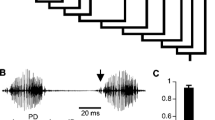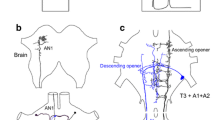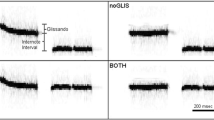Summary
-
1.
Essential and nonessential features of the male field-cricket (Gryllus campestris L.) calling song have been identified by varying acoustic parameters while testing for phonotactic tracking by females walking on the Kramer spherical treadmill.
-
2.
In the natural calling song, a 5-kHz carrier is modulated into 4-syllable chirps, repeated 2–4 times per second; the syllable rate within each chirp is near 30 Hz. Surprisingly, however, the majority of females that are ‘good trackers’ of calling song also track pure ‘trill’ — continuous 30-Hz trains of syllables having no chirp structure — for many minutes. Trill having identical sound power but the wrong syllable rate is not tracked.
-
3.
The ratio of syllable duration to syllable repetition interval — that is, the ‘duty cycle’, which is near 50% in nature — can be increased to as much as ca. 90% (intersyllable pauses as brief as 4–5 ms) without degrading tracking performance, as long as syllable repetition rate is near 30 Hz. Similarly, very short duty cycles — in the extreme case songs with syllables consisting of 200-μs ‘clicks’ — can elicit tracking of the sound source by the female.
-
4.
Fine details of the temporal structure of the syllables evidently do not convey information in our conditions, because (i)G. campestris females track both the maleG. campestris and the somewhat similar maleG. bimaculatus calling song, and (ii) tracking ofcampestris calling song is indistinguishable from tracking of the same song played backward.
-
5.
All the above results are compatible with the view that repetitive modulation near 30 Hz is the chief — and in some cases both necessary and sufficient — parameter of songs that trigger the neuronal ‘recognition’ of male song. Properties of alternative candidate mechanisms for such a process are described.
-
6.
As one test that may distinguish among such mechanisms, the range of syllable rates over which recognition is elicited is measured by a paradigm that keeps chirp duration, chirp rate and chirp energy approximately constant. At 80 dB, tracking is observed reliably in the range 20–40 Hz, whereas syllable rates below 15 Hz and above 50 Hz are largely rejected. Multiple-peak structure within this response spectrum, predicted by certain of the recognition mechanisms considered, is — if present — not resolved by our methods.
-
7.
Variation of the song parameter ‘carrier frequency’ to values above the natural ca. 5 kHz results in a striking phenomenon at high sound intensities. Maintained ‘tracking’ is observed, but at characteristic, erroneous angles with respect to the sound source. To compare this ‘anomalous phonotaxis’ with the negative phonotaxis reported in other gryllids during flight, we repeat Moiseff et al.'s (1978) ‘one-eared circling’ experiments on the Kramer treadmill, in three species of gryllids. InTeleogryllus, walking shows parallels to flight (reversal of one-eared circling in comparisons of 5 and 15 kHz) with respect to the carrier-frequency dependence of phonotaxis. WalkingGryllus andTeleogryllus evidently differ in this respect;Gryllus rarely exhibits negative phonotaxis (by one-ear criteria) at frequencies eliciting anomalous phonotaxis.
Finally, we show that simple pressure-gradient effects associated with the ipsilateral spiracular pathways could in principle account for the directional hearing observed inGryllus, and that the same formulation predicts anomalous directions of tracking, qualitatively like those measured, at elevated carrier frequencies. Such trial explanations evidently require drastic modification, however, if they are to account for the behavioral effects of blocking single tympanal and spiracular inputs.
Similar content being viewed by others
References
Autrum H (1941) Über Lautäußerungen und Schallwahrnehmung bei Arthropoden. II. Das Richtungshören vonLocusta und ein Versuch einer Hörtheorie für Tympanalorgane vom Locustidentyp. Z Vergl Physiol 28:326–352
Boyan GS (1980) Auditory neurones in the brain of the cricket,Gryllus bimaculatus (De Geer). J Comp Physiol 140:81–93
Dathe HH (1974) Untersuchungen zum phonotaktischen Verhalten vonGryllus bimaculatus (Insects, Orthopteroidea). Forma Functio 7:7–20
Esch H, Huber F, Wohlers DW (1980) Primary auditory neurons in crickets: Physiology and central projections. J Comp Physiol 137:27–38
Fletcher NH, Thwaites S (1979) Acoustical analysis of the auditory system of the cricket,Teleogryllus commodus (Walker). J Acoust Soc Am 66:350–357
Heiligenberg W (1969) The effect of stimulus chirps on a cricket's chirping (Acheta domesticus). Z Vergl Physiol 65:70–97
Helversen D von (1972) Gesang des Männchens und Lautschema des Weibchens bei der FeldheuschreckeChorthippus biguttulus (Orthoptera, Acrididae). J Comp Physiol 81:381–422
Helversen D von, Helversen O von (1981) Korrespondenz zwischen Gesang und auslösendem Schema bei Feldheuschrecken. Nova Acta Leopold (NF 54) 245:337–348
Hill KG (1974a) Acoustic communication in the Australian field cricketsTeleogryllus commodus andT. oceanicus (Orthoptera: Gryllidae). Thesis, University of Melbourne
Hill KG (1974b) Carrier frequency as a factor in phonotactic behaviour of female crickets (Teleogryllus commodus). J Comp Physiol 93:7–18
Hill KG, Boyan GS (1977) Sensitivity to frequency and direction of sound in the auditory system of crickets (Gryllidae). J Comp Physiol 121:79–97
Hill KG, Loftus-Hills JJ, Gartside DF (1972) Pre-mating isolation between the Australian field cricketsTeleogryllus commodus andT. oceanicus (Orthoptera: Gryllidae). Aust J Zool 20:153–163
Hill KG, Lewis DB, Hutchings ME, Coles RB (1980) Directional hearing in the Japanese Quail (Coturnix coturnix japonica) I. Acoustic properties of the auditory system. J Exp Biol 86:135–151
Huber F (1978) The insect nervous system and insect behaviour. Anim Behav 26:969–981
Jones MDR, Dambach M (1973) Response to sound in crickets without tympanal organs (Gryllus campestris L.). J Comp Physiol 87:89–98
Kleindienst HU (1980) Biophysikalische Untersuchungen am Gehörsystem von Feldgrillen. Dissertation, Universität Bonn
Kleindienst HU, Koch UT, Wohlers, DW (1981) Analysis of the cricket auditory system by acoustical stimulation using a closed sound field. J Comp Physiol 141:283–296
Larsen ON (1981) Mechanical time resolution in some cricket ears. II. Impulse sound transmission in acoustic tracheal tubes. J Comp Physiol 143:297–304
Larsen ON, Michelsen A (1978) Biophysics of the ensiferan ear. III. The cricket ear as a four-input system. J Comp Physiol 123:217–227
Lewis DB (1974) The physiology of the tettigoniid ear. I-IV. J Exp Biol 60:821–837, 839–851, 853–859, 861–869
Lewis DB, Coles R (1980) Sound localization in birds. Trends Neurosci (May) 1980:102–105
Moiseff A, Pollack GS, Hoy RR (1978) Steering responses of flying crickets to sound and ultrasound: Mate attraction and predator avoidance. Proc Natl Acad Sci USA 75:4052–4056
Moiseff A, Konishi M (1981) Neuronal and behavioral sensitivity to binaural time differences in the owl. J Neurosci 1:40–48
Murphey RK, Zaretsky MD (1972) Orientation to calling song by female crickets,Scapsipedus marginatus (Gryllidae). J Exp Biol 56:335–352
Nocke H (1972) Physiological aspects of sound communication in crickets (Gryllus campestris L.). J Comp Physiol 80:141–162
Oldfield BP (1980) Accuracy of orientation in female crickets,Teleogryllus oceanicus (Gryllidae): Dependence on song spectrum. J Comp Physiol 141:93–99
Paton JA, Capranica RR, Dragsten PR, Webb WW (1977) Physical basis for auditory frequency analysis in field crickets (Gryllidae). J Comp Physiol 119:221–240
Pollack GS, Hoy RR (1979) Temporal pattern as a cue for species-specific calling song recognition in crickets. Science 204:429–432
Pollack GS, Hoy R (1981) Phonotaxis to individual rhythmic components of a complex cricket calling song. J Comp Physiol 144:367–373
Popov AV, Shuvalov VF (1977) Phonotactic behavior of crickets. J Comp Physiol 119:111–126
Popov AV, Shuvalov VF, Svetlogorskaya ID, Markovich AM (1974) Acoustic behaviour and auditory system in insects. In: Schwartzkopff J (ed) Symp mechanoreception. Abh Rheinisch-Westfäl Akad Wiss 53:281–306
Reiss RF (1962) A theory and simulation of rhythmic behavior due to reciprocal inhibition in small nerve nets. Proc AFIPS Spring Joint Computer Conference 21:171–194. National Press, Palo Alto, California
Reiss RF (1964) A theory of resonant networks. In: Reiss RF (ed) Neural theory and modeling. Proc of the 1962 Ojai Symposium. Stanford University Press, Stanford, California, pp 105–137
Shuvalov VF, Popov AV (1973a) Significance of some of the parameters of the calling songs of male cricketsGryllus bimaculatus for phonotaxis of females. J Evol Biokh Fiziol 9:177–182
Shuvalov VF, Popov AV (1973b) The importance of the calling song rhythmic pattern of the males of the genusGryllus for phonotaxis of females. Zool J 52:1179–1185
Shuvalov VF, Popov AV (1979) On spectral selectivity and conditions of stimulation in phonotactic behavior of crickets (Gryllus bimaculatus De Geer). Dokl Akad Nauk SSSR 246:247–249
Stout JF, Huber F (1981) Responses to features of the calling song by ascending auditory interneurones in the cricketGryllus campestris. Physiol Entomol 6:199–212
Tschuch G (1976) Der Einfluss synthetischer Gesänge auf die Weibchen vonGryllus bimaculatus de Geer. Zool Jahrb Physiol 80:383–388
Tschuch G (1977) Der Einfluss synthetischer Gesänge auf die Weibchen vonGryllus bimaculatus de Geer (Teil 2). Zool Jahrb Physiol 81:360–372
Walker TJ (1957) Specificity in the response of female tree crickets (Orthoptera: Gryllidae: Oecanthinae) to calling songs of males. Ann Entomol Soc Am 5:626–636
Weber T, Thorson J, Huber F (1981) Auditory behavior of the cricket. I. Dynamics of compensated walking and discrimination paradigms on the Kramer treadmill. J Comp Physiol 141:215–232
Wendler G, Dambach M, Schmilz B, Scharstein H (1980) Analysis of the acoustic orientation behavior in crickets (Gryllus campestris L.). Naturwissenschaften 67:99–101
Wohlers DW (1980) Anatomical and physiological studies of the auditory pathway in crickets. Dissertation, University of Munich
Wohlers DW, Huber F (1982) Processing of sound signals by six types of neurons in the prothoracic ganglion of the cricket,Gryllus campestris L. J Comp Physiol 146:161–173
Zaretsky MD (1972) Specificity of the calling song and short term changes in the phonotactic response by female cricketsScapsipedus marginatus (Gryllidae). J Comp Physiol 79:153–172
Zhantiev RD, Kalinkina IN, Shukanov VS (1975a) Characteristics of the directional sensitivity of the tympanal organs in the cricketGryllus bimaculatus DeG. (Orthoptera, Gryllidae). Entomol Obozr 54:249–257
Zhantiev RD, Kalinkina IN, Shukanov VS (1975b) Functional characteristic of two auditory interneurons in the cricketGryllus bimaculatus DeGeer (Orthoptera, Gryllidae). Vestn MGU Ser Biol 6/2:18–25
Author information
Authors and Affiliations
Additional information
This paper is respectfully dedicated to Prof. H. Autrum on the occasion of his 75th birthday
Supported by the Deutsche Forschungsgemeinschaft as part of the Priority Program ‘Neurale Mechanismen des Verhaltens’ (Ot 62/4)
Rights and permissions
About this article
Cite this article
Thorson, J., Weber, T. & Huber, F. Auditory behavior of the cricket. J. Comp. Physiol. 146, 361–378 (1982). https://doi.org/10.1007/BF00612706
Accepted:
Issue Date:
DOI: https://doi.org/10.1007/BF00612706




